Although college is a costly commitment, there are a variety of financial help options like Things About Student And Education Loans. Some forms of financial assistance, such as grants and scholarships, may not need repayment. On the other hand, loans must be repaid with interest. While a result, it’s critical to be well-informed as you and your child choose whether or not to take out college loans.
loans assist students in paying for college by covering financial gaps and supplying necessary finances to meet educational. To make responsible, effective decisions about supporting your education, you must completely grasp the application process, distribution, and payback criteria related to loans.
Here are 7 Things About Student And Education Loans;
1. Types of Student Loans
Federal loans and private loans are the two primary forms of loans.
Things About Student And Education Loans:
Come from the federal government, as you might expect. They are often less expensive than private student loans and should be your first choice. You may wish to seek a private student loan if your child does not qualify for enough grants, scholarships, or federal student loans. In general, public student loans are better than private student loans since the federal government provides more borrowing and repayment flexibility Things About Student And Education Loans. Things About Student And Education Loans: Student loans from the federal government
Furthermore, private student loans have higher interest rates than public student loans. However, if a student does not obtain enough financial help to pay college costs, private loans might be a decent backup choice.

Things About Student And Education Loans:
They are standard credit-based loans taken out in the name of the child. Things About Student And Education Loans: Student loans from private lenders. You will almost certainly be required to sign as a guarantor unless your child has a credit or job history. This is a promise to pay back the debt if your child fails to do so. Some lenders have maximum loan amounts, while others will allow you/your child to borrow up to the total cost of your child’s education Things About Student And Education Loans.
Interest rates vary and are dependent on credit and the economy. Usually, your child will be allowed to defer payments until after completing school. Sometimes lenders also allow a six to nine-month grace period following graduation. Others may require payments while still in school or immediately after graduation.
2. Debt varies widely by state and college.
Things About Student And Education Loans: Debt varies widely by state and college. While not officially a state, Washington, D.C. topped the list of states with the most debt, with an average of $55,729 – more than $15,000 more than Georgia, which had an average of $40,692. Wyoming, North Dakota, South Dakota, and Iowa are at the bottom of the list (or at the top, depending on your point of view), all with less than $30,000.
Similarly, the degree students choose can have a significant influence on the amount of student debt they will have when they graduate. Graduate school costs vary greatly depending on the program. Specialized degrees, such as medicine, law, or pharmacy, can result in significantly larger debt loads, occasionally exceeding $100,000.

3. Repayments of Loan is based on your income, not how much you borrowed
Unlike other types of borrowing, the amount you return is determined by your income rather than the amount you owe. If your income exceeds the repayment threshold for your plan type, you repay 9% of it. You won’t have to make any payments if you don’t work or if your income is below the level. Things About Student And Education Loans: Repayments of Loan is based on your income, not how much you borrowed
4. Subsidized vs. Unsubsidized Loans
loans can be subsidized or unsubsidized, based on the family’s financial needs. If your child is eligible for a subsidized loan, the government will pay the interest while they are in school and for the first six months after they graduate. Students who take out unsubsidized loans are responsible for the whole cost of interest. Things About Student And Education Loans: Subsidized vs. Unsubsidized Loans

All Perkins loans are subsidized since they are given to students who have the greatest financial need. Additionally, Perkins loan recipients are offered a nine-month grace period after graduation. They’ll have to start paying interest on the loan when the nine months are up. The findings of your FAFSA will decide whether your kid receives a subsidized or unsubsidized Direct Stafford loan.
5. Requirements for Loan Forgiveness
There are several federal student debt forgiveness programs that will forgive your balance once you make a set number of payments. The federal Public Service Loan Forgiving Program is one of these forgiveness schemes (PSLF). If you work full-time for the government at any level or for certain not-for-profit organizations and make 120 qualifying payments throughout your tenure of employment, you may be eligible to have your loans forgiven under PSLF. Pat Williams, a West Chester University alumnus, says, “I wish I knew how the Public Service Loan Forgiveness program truly worked.
” Williams served in the military, which is a qualified kind of public service. However, when he took out federal loans, he chose an Extended Repayment Plan, which was previously ineligible for PSLF, and as a result, his loans were erroneously disqualified for forgiveness. Borrowers who have chosen an Extended Repayment Plan may now be eligible for PSLF. Still, if you want to take advantage of debt forgiveness, make sure you’re aware of all the conditions and recent revisions to ensure you’re still qualified. Things About Student And Education Loans: Requirements for Loan Forgiveness
6. Students Loan comes with an interests
Due to loan fees and interest, you’ll owe more than the amount you borrowed. You must pay a loan charge, which is a percentage of the total loan amount, on all federal loans. For students, the current loan fee for federal direct student loans is 1.057 percent. You’ll also have to pay interest on your loan, which accrues every day and is added to the total amount you owe when repayment begins. The current fixed federal undergraduate loan interest rate is 3.73 percent, however, it fluctuates year to year. Your or your co-credit signer’s history will be used by private lenders to calculate your rate. Things About Student And Education Loans: Students Loan comes with an interests
7. Loan can only be used for educational-related expenses
Only education-related costs are eligible for loan funds. Your loan cannot be used for entertainment, takeaway, or vacations, but it can be used for transportation, food, study abroad expenses, personal supplies, or off-campus housing. Things About Student And Education Loans : Loan can only be used for educational-related expenses









